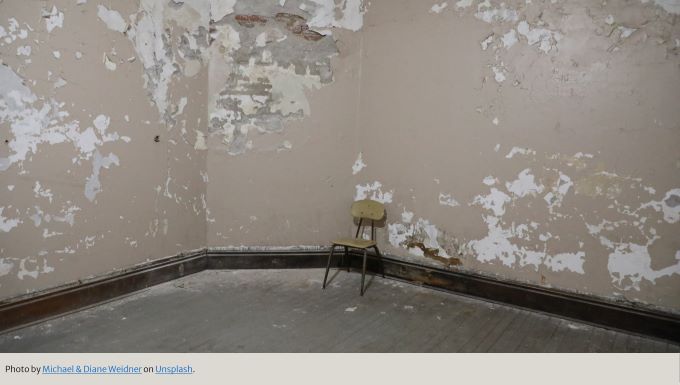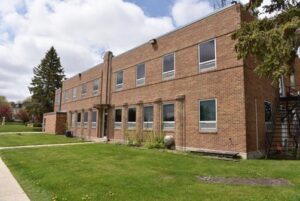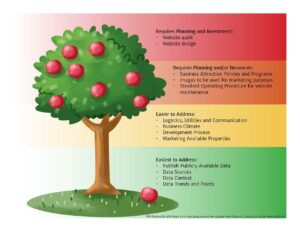Intro
Sad. Depressed. Scary. That neighborhood. That building.
What images came to mind? Maybe you can easily recall properties in your community that fit this description. Buildings with weeds growing up through the concrete parking lot. Buildings that have graffiti tags, broken glass, and/or burned siding. My colleagues have outlined the financial rewards and boomerang benefits to be gained for property owners proactively maintaining and improving their properties. Check out their articles The Financial Incentive for Property Improvement and ROI of RE – the Boomerang Benefits. Here, however, we will explore the environmental and public health costs of neglected buildings. Above all, the intention of this article is to empower economic development professionals with some resources and strategies to start the conversation with property owners in their communities.
Common Building Maintenance Issues & Threats
Broken windows, damaged roofs, gutters filled with debris, compromised foundations, broken plumbing, and unsafe electrical work, for example, create opportunities for natural elements to wreak havoc. Water damage and fire hazards most certainly compromise the integrity of the structure. Delaying the window repair, for example, could permit mold to thrive, drywall to sag and crumble, and wood to rot quickly becoming a public health concern.
Fixing the problems has financial and environmental costs. Consider the energy consumed and carbon emitted during the repairs. If repairs are delayed, the building may be past the point of no return. At this point, tearing the building down would further impact landfills and fumes from diesel engines into the atmosphere.
Some might suppose that leveling an old building and building a new, more energy-efficient building would be better. A study by the National Trust for Historic Preservation Green Lab, however, found that it “takes 10 to 80 years for a new building that is 30 percent more efficient than an average-performing existing building to overcome, through efficient operations, the negative climate change impacts related to the construction process.”[1]
Distressed Properties and Public Health Costs
Community stakeholders reflect with sadness remembering the neighborhood as it once was and how much it has changed since then. Sometimes, there is a sense of hopelessness due to circumstances beyond their control. Other times, however, there is anger towards negligent or absentee property owners looking to conserve their financial bottom line and not considering the environmental and public health costs.
For example, an occupied building in disrepair can have profound and lasting health costs on its tenants. Mold, fungi, and allergens from pests, can lead to respiratory diseases like asthma and other physical illnesses for instance. A correlation has also been found to exist between “household disrepair (e.g., leaky structures, broken plumbing, broken windows, and pests) and symptoms of distress”[2] such as neurological disorders, psychological and behavioral dysfunction.
For example, structures built prior to 1978, may contain lead-based paint and lead pipes. These housing issues can lead to “neurological damage and impaired development, reduced IQ, and negative cognitive and behavioral effects such as hyperactivity, increased aggression, learning disabilities, and behavioral problems”.[3] Furthermore, gases (e.g. carbon monoxide and radon) can lead to headaches, nausea, dizziness, convulsions, cancer, and fatality.
In fact, research suggests that there is a higher correlation between a person’s life expectancy and their zip code than their genetic code. “. . . the ‘broken window theory’ suggests that vacant properties and neighborhoods with persistent blight create a climate of social and psychological disorder that attracts criminal activity and violence and becomes a breeding ground for vermin (Branas et al. 2011).”[4] Therefore, it is also reasonable to assume that if children and their families do not feel safe being active outdoors, they will become more sedentary. A sedentary lifestyle has been linked with obesity, Type 2 Diabetes, heart disease, anxiety, depression, and more.[5]
Prevention Strategies
An ounce of prevention is worth a pound of cure. – Benjamin Franklin.
So, what can be done to proactively prevent negligence and/or mitigate the environmental and public health costs of blighted buildings and neighborhoods? Here are a few suggested strategies:
- Stakeholder education and engagement
- Licensing, permitting, and code enforcement
- Action via Redevelopment Authority
- Greening vacant lots
Stakeholder Education & Engagement
First, don’t assume what “everyone knows.” For example, staff, owner, and tenant turnover doesn’t always facilitate knowledge transfer. To mitigate this phenomenon, economic and community development professionals could create a forum to meet annually with property owners and tenants for example. Topics could include the economic, environmental, and public health benefits of building maintenance and the alternative costs of delaying repairs. Local ordinances ensuring consistency in expectations, who to call for help, and available programs to help address building maintenance issues should also be discussed. Meeting in person, while not always feasible, is best for relationship development and cultivating trust. Collaborating agencies should provide contact information and links to these valuable resources on their respective websites.
Licensing, permitting, and code enforcement
Second, code enforcement is often complaint-based and reactive rather than proactive. Some tenants may also fear retaliation by their landlord such as eviction if they file a complaint. Requiring permits and licenses are some ways building officials can track occupancy and maintenance issues. Some municipalities have also required landowners to register vacant buildings. This generates an inventory of buildings to monitor for public safety.
Action via Redevelopment Authorities
Created and empowered by the local jurisdiction, redevelopment authorities are tasked with blight elimination and planning efforts to encourage investment. Furthermore, in Wisconsin, Redevelopment Authorities have the power of eminent domain and borrowing capacity to acquire properties, clear sites, and redevelop vacant properties.
Greening vacant lots
In the meantime, if the lot is cleared of blighted property, creating green spaces on vacant lots “can significantly contribute to an individual’s physical as well as psychological well-being (Tzoulas et al. 2007).”[6] These spaces can become gathering places for social activities and add to the community’s vitality. Detroit Future City, a think tank, has created a field guide for designing green spaces on vacant lots. Designs vary by use, size, and capacity.
Conclusion
The list of environmental and public health impacts of vacant and neglected buildings is far from exhaustive. Neither is the list of strategies for proactively addressing and mitigating blighted properties. Economic and community development professionals are creative, results-driven, relationship builders. Our hope is that this discussion has added fuel to the conversation in your community.
[1] The National Trust for Historic Preservation Green Lab. (2016). The Greenest Building: Quantifying the Environmental Value of Building Reuse. https://forum.savingplaces.org/viewdocument/the-greenest-building-quantifying
[2] de Leon, Erwon & Joseph Shilling. Urban Blight and Public Health. (2017). Urban Institute. https://www.urban.org/sites/default/files/publication/89491/2017.04.03_urban_blight_and_public_health_vprn_report_finalized.pdf
[3] Ibid.
[4] Ibid.
[5] Sitting is the new smoking. https://www.startstanding.org/sitting-new-smoking/#extended
[6] de Leon, Erwon & Joseph Shilling. Urban Blight and Public Health. (2017). Urban Institute. https://www.urban.org/sites/default/files/publication/89491/2017.04.03_urban_blight_and_public_health_vprn_report_finalized.pdf






